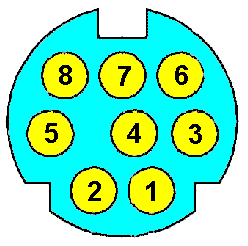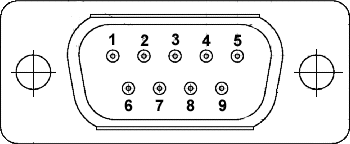


The pins on the camera's female mini DIN connector and the PC's male DB-9 connector are numbered as in the following diagrams:


Note: The above diagrams show the relative pin positions when looking at the connectors on the camera and on the PC, respectively (i.e., these are what the camera cable plugs into). Alternatively, one could view these as diagrams of the back-side of the cable's two connectors.
Pins 1 through 8 on the mini DIN are wired to pins 1 through 8 respectively on the DB-9 serial port connector, as follows:
DIN DB-9 Signal Name Direction
--- ---- ----------- ---------
1 1 Carrier detect (CD) input to PC
2 2 Receive data (RxD) input to PC
3 3 Transmit data (TxD) output from PC
4 4 Data terminal ready (DTR) output from PC
5 5 Signal ground (Gnd) -
6 6 Data set ready (DSR) input to PC
7 7 Request to send (RTS) output from PC
8 8 Clear to send (CTS) input to PC
- 9 Ring indicator (RI) input to PC
Since the "photopc" software works with "hardware flow control" turned
off, this implies that only pins 2 (RxD), 3 (TxD), and 5 (Gnd)
are important.
We have a report that the Epson PhotoPC "Classic" serial cable described here also works with the Polaroid Fun 640 SE digital camera.
Pinouts for the Epson PhotoPC 700 digital camera's serial cable were supplied by Dave Wilson (DWILSON@CablePlus.com). Thank you Dave!
Pinouts for the Agfa Ephoto 307 digital camera's serial cable were found on one of Stephen Taylforth's Web pages.
Another pinout diagram for the Agfa Ephoto 307 digital camera (a bit easier to decipher) was provided by Maxim A. Naumov, a result of his reverse-engineering exercise, sans cable.
Note: Information on other compatible digital camera's serial cables would be most welcome. Please send data/links to lightner@lightner.net.
To help make the "electrically inept" a bit braver about making their own camera cable, I wouldn't worry too much about possibly getting the wiring wrong at first and damaging something. PC serial ports use RS-232 signaling, which is electrically "robust" in that the inputs and outputs are protected against short circuits and unusual voltages. In my 30+ years of abusing RS232 serial port wiring, I have yet to damage a serial port. (However, you are on your own! And, please value this information according to what you paid for it!)